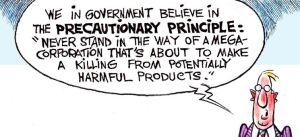 The precautionary principle – the idea that one should adopt an approach that minimises risk – is so ingrained in the mind of the conservation scientist that we often forget what it really means, or the reality of its implementation in management and policy. Indeed, it has been written about extensively in the peer-reviewed conservation literature for over 20 years at least (some examples here, here, here and here).
The precautionary principle – the idea that one should adopt an approach that minimises risk – is so ingrained in the mind of the conservation scientist that we often forget what it really means, or the reality of its implementation in management and policy. Indeed, it has been written about extensively in the peer-reviewed conservation literature for over 20 years at least (some examples here, here, here and here).
From a purely probabilistic viewpoint, the concept is flawlessly logical in most conservation questions. For example, if a particular by-catch of a threatened species is predicted [from a model] to result in a long-term rate of instantaneous population change (r) of -0.02 to 0.01 [uniform distribution], then even though that interval envelops r = 0, one can see that reducing the harvest rate a little more until the lower bound is greater than zero is a good idea to avoid potentially pushing down the population even more. In this way, our modelling results would recommend a policy that formally incorporates the uncertainty of our predictions without actually trying to make our classically black-and-white laws try to legislate uncertainty directly.
Of course, the non-science world tends not to think probabilistically (indeed, we have a helluva time getting our own students to understand probability theory) despite the attraction of the logic. For example, I have sat in a policy meeting where by-catch limits were being set for a particular threatened species being caught in a local fishery. Here, a scientist showed some analysis indicating a 95% probability that the by-caught species was declining in abundance since by-catch was first observed. An industry representative at the meeting then claimed therefore that there was a 5% chance the species was increasing, and so we shouldn’t worry about it. Not only did he not understand the statistic, he was perfectly happy to take the (rather high) risk of seeing the species disappear for the benefit of his future profits. It’s not a very rare sentiment in business these days.
So when I saw this post in The Guardian last week, it got me thinking again about how the precautionary principle was being used in environmental laws, and whether the assumption among conservation scientists of its ubiquity and acceptance is being upheld. A little research indicates that it’s almost entirely absent from society’s general approach to biowealth protection.
We’ve failed to arrest the global decline of biodiversity, and even our protected areas are gasping, with about half of tropical protected areas losing their biodiversity, and national reserve systems [at least, in Australia] dying a death of a thousand cuts. It’s not just the biodiversity itself that’s suffering – society is losing trillions of dollars worth of biowealth and our natural wealth-adjusted index of economic prosperity has been declining since 1978.
So clearly on a global scale, we’re not being very precautionary at all. At a more local scale, I note that in addition to national parks being stripped of their legal protection, Australia’s Environmental Protection Authorities have been systematically removing so-called ‘green tape’ to make it much easier for industry to implement [short-term] economic development of limited long-term gain. We tend to sigh in relief when toothless ‘State of the Environment’ reports seemingly indicate no further decline in particular categories, while shifting baselines ensure we forget the collective destruction that has already occurred.
In other words, the very legislation designed to protect our life-support systems now runs almost completely on a ‘innocent-until-proven-guilty’ assumption. That is, industry may proceed if no one can find [usually a threatened] species that will be directly affected (i.e., someone must prove that there will be a negative effect). This is usually an impossible ask anyway because EPA approval is generally based on a cursory survey of the macro-species within the immediate vicinity. Even then, our laws still favour environmental destruction given proposals to offset localised losses through biodiversity trading, even though the concept is so fundamentally flawed as to be laughable (see also here).
So what to do? A pragmatic and visionary government would instead invoke a ‘guilty-until-proven-innocent’ policy where industry would have to demonstrate that a development would cause no biodiversity loss before proceeding (i.e., they would have to prove that there wouldn’t be a negative effect). Given our track record, one could argue that this condition might never be met, but some middle ground would certainly be preferable to our current approach. A smart government would also view its short-term economic gains within the light of better long-term economic indicators, such as the Genuine Progress Indicator I wrote about a few weeks ago.
Some decisions will be harder than the mere change of our approval philosophy might imply. Things like developing nuclear power in favour of coal, how to deal with over-population and providing enough food for humanity now and into the heated future, are all contentious issues. But following the paths of lowest long-term detriment to me seems like an intelligent way forward. Demanding such from our governments will be a life-long challenge for all of us.
CJA Bradshaw

